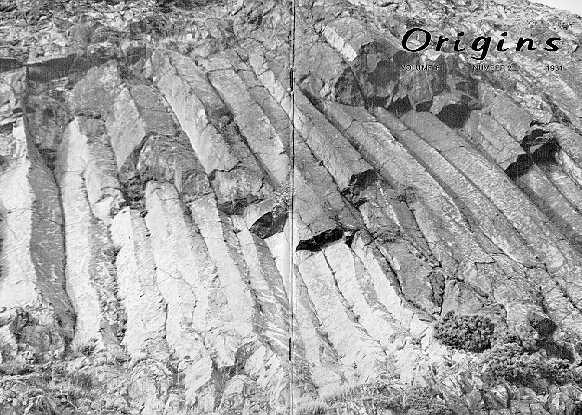©Copyright 2018 GEOSCIENCE RESEARCH INSTITUTE
11060 Campus Street • Loma Linda, California 92350 • 909-558-4548

HISTORICAL DEVELOPMENT OF THE CURRENT UNDERSTANDING OF THE GEOLOGIC COLUMN: PART I
by
Richard Ritland
Professor of Biology
Andrews University,
Berrien Springs, Michigan
WHAT THIS ARTICLE IS ABOUT
In the past 250-300 years a major paradigm shift has taken place regarding the history of the earth. It would be safe to say that prior to this time period a large majority of practicing scientists either held a strong belief in a biblical account of origins or at least were not antagonistic to such a concept. Parallel to this belief was the development of geology, a separate discipline or science. Observations that showed similarity of rock and fossil types over large geographical ranges were begun to be appreciated as well as the uniqueness of certain strata with respect to the presence or absence of various life forms. These studies resulted in various theories which attempted to explain the geologic picture.
A major influence early in this time of new models was A. C. Werner (1749-1817). Werner held that the various rock layers were formed by precipitation of materials from turbid seas. Werner and his followers (the Neptunists) presented a major diversion from the traditional interpretation. James Hutton (1726-1799) recognized the true nature of some rocks as being volcanic in origin and overemphasized this source of material in the fossil record. The concept of erosion and deposition was also developed by Hutton with the slowness of this process recognized.
William Smith (1769-1839) recognized the widespread occurrence of various layers and his work implied major geologic changes over wide areas. In addition to the stratigraphic studies, analysis of fossil remains also began. Dominant in these areas was the work done by Georges Cuvier (1769-1832). A comparative anatomist, Cuvier was able to make identifications of fossil fragments and place them into taxonomic groups. With these studies came the realization that fossils might be used as indices in identifying similar but widely separated strata. Cuvier also developed the concept that the geologic record is the result of short catastrophic bursts with long, quiet intervals between. These forerunners provided a milieu in which the future formulators of the geologic column could now work.
INTRODUCTION TO THE COLUMN
The crucial questions on the relationship of Genesis and geology, of religion and geological science nearly all hinge in some way on one's understanding of the meaning and significance of the geologic column. It is important, therefore, to understand something of its origin as a system.
Most commonly the term geologic column is applied to a composite columnar section in which there is an attempt to superimpose rocks representing every period of time for the world as a whole. In this way it is thought that the column can be used somewhat like a calendar for dating rock formations and as a unifying concept, a datum in relation to which a large part of the vast fund of geological information and theory can be organized. In the various major regions of the world, locations with favorable exposures and typical deposits for individual segments of the column (epoch or series divisions) may be selected as type sections for use in correlation, as, for instance, the magnificent, little disturbed Middle Cambrian formations of the Canadian Rockies (the Albertan Series) to which Middle Cambrian rocks throughout North America are compared.
Time units used in the geologic column include eras, the major divisions such as Paleozoic, Mesozoic and Cenozoic; periods, the first subdivisions of eras including Cambrian, Ordovician, Silurian, etc.; epochs, the subdivisions of periods such as Lower, Middle and Upper Cambrian, or Paleocene, Eocene and so on in the Tertiary period; and stages, divisions of the epochs used primarily by specialists. For each time division there is a unit of strata equivalent. Only eras, periods and epochs are usually listed on most geologic columns, and sometimes only the epochs for the most recent periods (see Table 2).
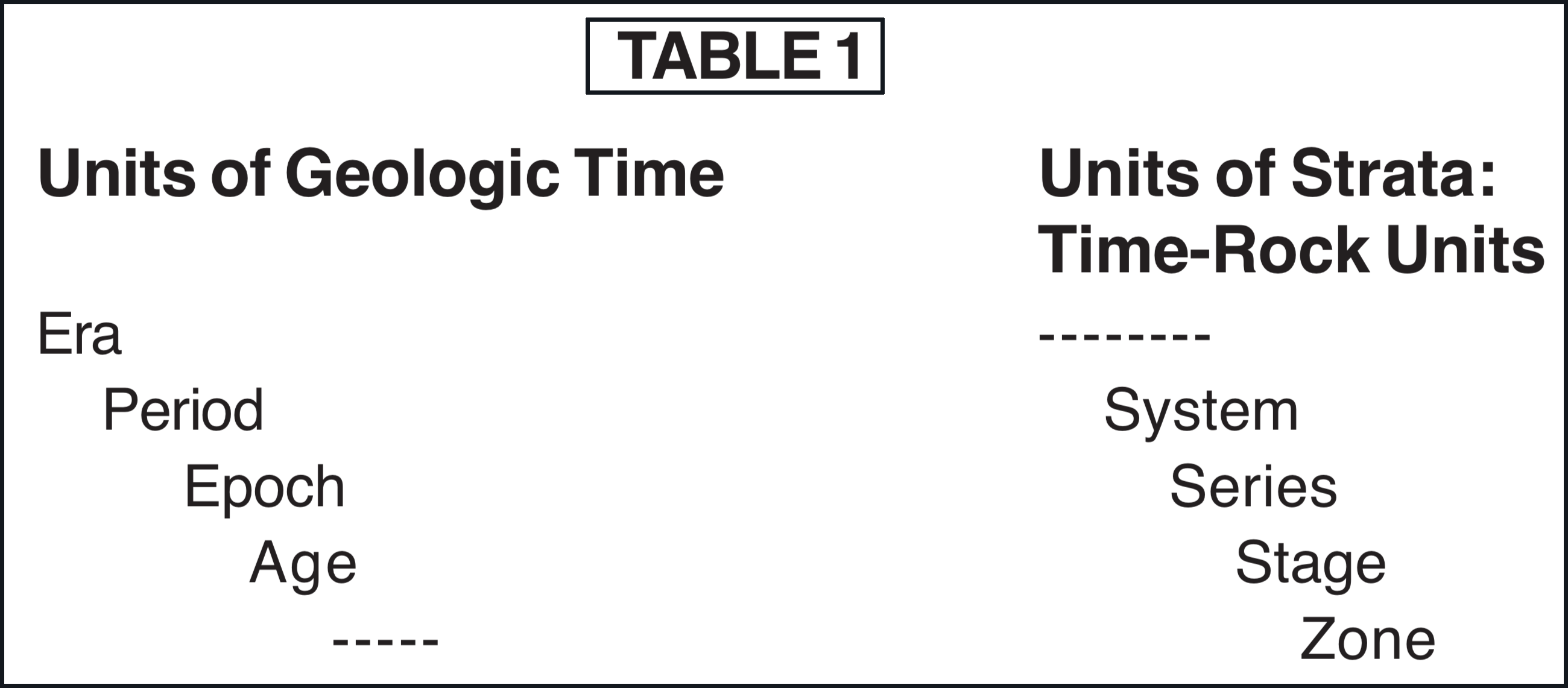
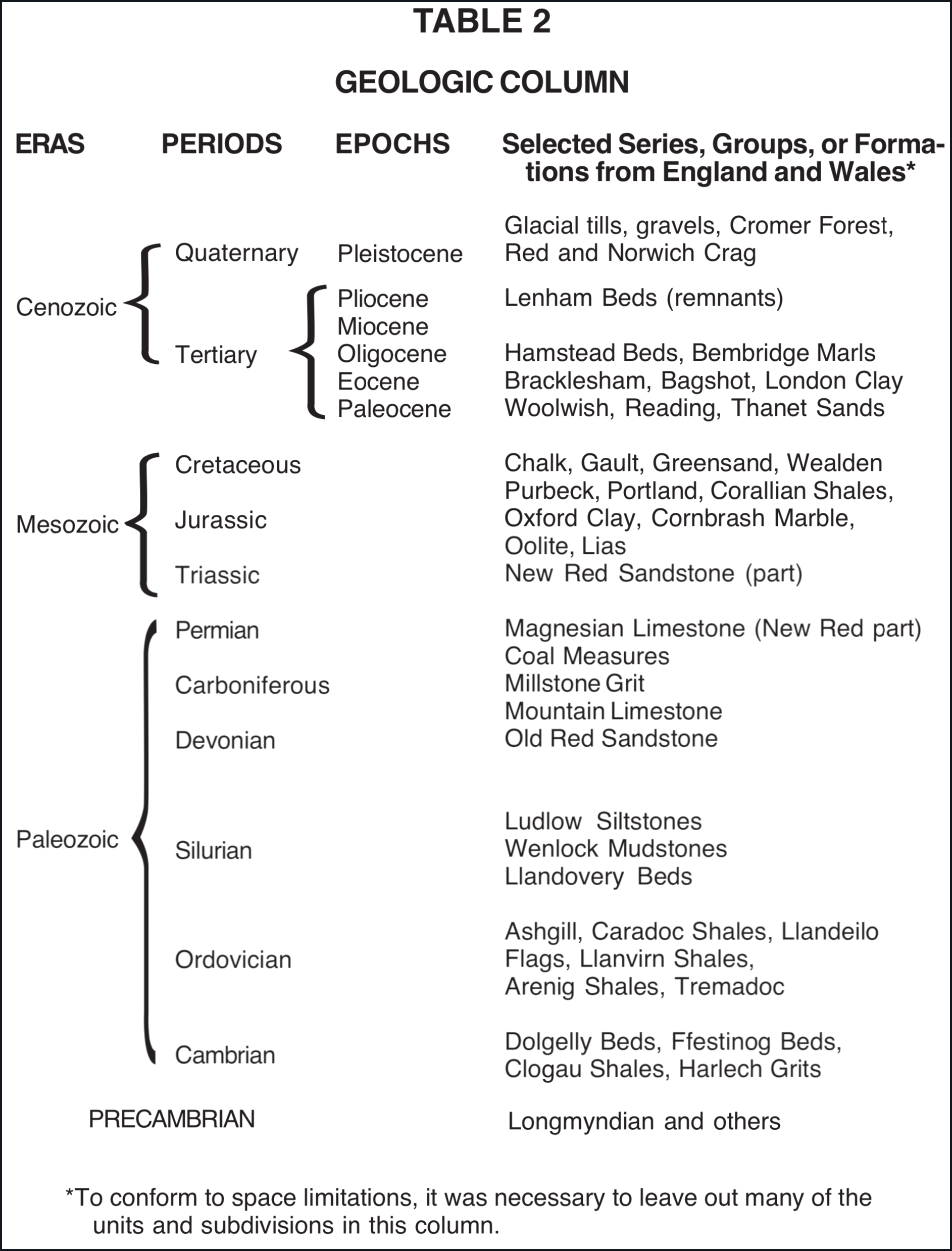
Upon reflection it is obvious that substantial deposition cannot normally occur over the entire earth's surface at the same time. There must always be a source for every particle of gravel, sand, lime, silt or lava which is deposited. It follows that no single interval or moment in earth history can be everywhere represented by deposits. There are no universal formations.
Moreover, since there is much evidence to support the view that no single region has continuously received deposits from the time of the creation of the planet until now, in developing a complete "geologic column" for the world it is necessary to attempt to correlate strata so that any level where non-deposition or an erosional break has occurred may be represented by rocks from other areas laid down at the time of the missing interval. This introduces a subjective element, but fortunately there are hundreds of regions with extensive series of superimposed strata representing major segments of the column, and there are diverse criteria for correlation available so that correlations necessary may generally be quite firmly established.
Approximately three quarters of the total land area of the planet is blanketed by many layers of sediments, commonly transformed into stratified rock (Putnam 1964:21). With an average aggregate thickness of several thousands of feet, these strata vary from level to level. More often than not traces of past life called fossils are preserved in these layers. Sequences of these layers or strata which have similar lithological, fossil and structural characteristics, hence distinguishable in the field from other such sequences, are called rock formations. Formations are usually given names associated with a location where the unit is typical and well exposed the type locality.
While generally there are no more than two or three dozen rock formations, and often only one or a few exposed on any single canyon wall, mountain slope or well core, it is estimated that in aggregate there may be 13,000 formations in North America and possibly 100,000 in the world (Dunbar and Rodgers 1957:289). Information about just the fossils in a single important formation is, in many cases, the subject of a score or more of technical articles and/or perhaps one to several book-length volumes. Studies on the lithology, sedimentary features, solution phenomena, ores, etc., may occupy more articles or volumes.
The data are vast. It is essential to be able to correlate beds from one basin to the next, and even from one continent to another as far as possible. Several of the characteristics used include: assemblages of fossils which appear to be restricted to a limited vertical range in the column (guide or index fossils), relative position in a sequence, direct physical continuity in the field, lithological characteristics, geophysical and geochemical characteristics, etc. Guide fossils and relative position are often most useful.
Because of the great ages commonly assigned to the periods and epochs of the geologic column, and because it is often alleged that the column of fossil-bearing rock documents, at least in a partial way, the record of the evolution of life on the earth, the geologic column has been the subject of sharp controversy. It has been totally rejected by some, and partially or completely reinterpreted by others. Students who use the terminology of the column are sometimes viewed with considerable suspicion. Many conservative Christians and fundamentalists believe that the geologic column represents a scheme by which the strata of the earth have been arranged in an artificial order so as to support false claims of evolution. Some have felt that the true relation of fossils to one another and to living forms has been concealed by a disguising terminology deliberately constructed to deceive by scientists who have been seeking to escape the moral imperatives set forth in the Holy Scriptures (Price 1926: e.g., 112, 175, 205).
The purpose of this paper is to attempt to reconstruct as far as possible significant presuppositions, beliefs and biases the crosscurrents influencing thought and interpretation of those men who established the foundations of geology and the geologic column. It is beyond the scope of this study to evaluate the relative merits of competing viewpoints. This paper cannot more than sample the lines of evidence interpreted by geologists of those decades as requiring a greatly expanded time frame for earth history, nor to more than mention the existence, much less the interpretations and arguments, of the conservative opponents since they were not involved in the formulation of the geologic column.
Part I (this issue) includes a definition of the geologic column, together with several basic terms, an outline of early systems of classification of strata, samples of typical views concerning fossils in the prescientific period of geology, and a brief consideration of men who laid the foundation for the scientific study of geology in the early 19th century. Part II (next issue of ORIGINS) focuses on the men who formulated the geologic column between 1820-1850, their attempts to harmonize geology and Genesis, and conservative opposition to their views.
EARLY OBSERVATIONS AND VIEWS
Before 1800 Systems of Classification
In the eighteenth century, associated with an increased utilization of earth materials coal, metals and other minerals several proposals for classification of the rock layers of the earth's crust were introduced. Deserving of special mention are three which embody a recognition of a chronological sequence, of an orderly succession of strata, and of geological processes involved in erosion, sedimentation and preservation of fossils accepted concepts today, but largely unappreciated before the 18th century. Preflood, flood, and postflood formations were postulated. These three were largely free from the fanciful speculations so characteristic of most contemporary authors.
In 1756 Johann Gottlob Lehmann, a mining engineer and teacher in Berlin who investigated the rocks of Prussia, published a wealth of careful observations together with his ideas on the origin and composition of the earth's crust (Adams 1938:374-478; Zittel 1901:35). Lehmann recognized three major categories of mountains:
- The most ancient class of mountains composed of rocks of a crystalline nature, hard, structurally complex, and chiefly without fossils, were designated Primitive (equivalent to Primary of Arduino). These primeval mountains were generally of higher elevation, with strata often inclined or vertical, plunging to unknown depths. They were thought to have been formed before the universal deluge in the early periods of creation.
- 2. The Flötzgebirge or horizontal mountains were composed of successive, stratified, water-laid sediments and often contained animal and plant fossils (designated Secondary by Arduino and later authors). Many of these formations were thought to have been deposited at the time of the universal deluge. Such strata were considered "secondary" in the sense that they were composed of particles eroded from the older rocks of the "primitive" or "primary" mountains. Lehmann gave accurate descriptions, with sections and diagrams, of thirty successive "bands" in the Permian rocks of Thuringia. The recognition of a definite order and the aqueous origin of the sediments enhanced the merit of his work on secondary formations.
- 3. Later deposits, including mountains formed from time to time (e.g., volcanic mountains), and loosely consolidated surficial sands and gravels, commonly termed Alluvial, comprised his third division.
George Christian Füchsel (1722-1773), a less well-known contemporary of Lehmann living in Prussia, worked on Triassic strata and contributed significantly to the foundation for later studies in stratigraphy. Füchsel developed the concept of a rock formation as a depositional unit representing a certain epoch of time. Such formations were not thrown out at random, but deposited initially in a horizontal position as part of a clearly delineated, orderly succession under circumstances that may be inferred from the lithology and characteristic fossil assemblage. He felt that the most recent deposits in his district, which contained only terrestrial fossils, were from "the action of a great deluge." Lyell (1834:76) states that Füchsel manifested a "strong desire ... to explain geological phenomena as far as possible by reference to the agency of known causes."
Giovani Arduino (1713-1795), an inspector of mines in the province of Tuscany, and later Professor of Mineralogy in Venice, gave us the threefold division of the rocks of the earth's crust: Primary, Secondary and Tertiary. "Tertiary" is still retained for a period, or system, of the Cenozoic.
- Primary or Primitive These were unfossiliferous rocks including schist, gneiss, quartz veins, highly folded rocks, etc.
- Secondary Included were several groups of strata with limestones, marls, clays, etc., all with fossils. Rocks recognized as Cretaceous by later workers were included as the uppermost unit in this division. In most of the 18th and 19th century literature, "Secondary" was applied to the vast series of strata from the mid-Paleozoic through Mesozoic (see Table 3).
- Tertiary "Arduino's Montes tertiarii consists of younger and highly fossiliferous series of limestones, sand, marl, clay, etc., and he observes that the material of these can in many cases be shown to have been derived from the Secondary series" (Zittel 1901:38).
This observation of the recycling of material from older to younger fossil-bearing strata, which was encountered in many rock formations, also impressed many later workers with the need for successive epochs. It seemed necessary to account first for initial deposition and burial of fossils, followed by lithification, then by break-up, erosion of the formation, transport, incorporation into another sediment, followed by lithification of the new deposit (see, for example, Conybeare and Phillips 1822:xiv). - In addition to the three major divisions, a series of submarine lava and tuff deposits were placed in a Volcanic division.
It is not surprising that in Italy, a land where strata of the mountains to the north were twisted and contorted and where volcanoes and earthquakes resulting in change of the level of the land in relation to the sea were of repeated occurrence, Arduino would conclude that the earth had "undergone repeated upheavals and subsidences, many 'revolutions' and 'metamorphoses'" (Adams 1938:374). The gradual evolution of the concept that many of the formations represented deposits at successive periods of time served to pave the way for views that were to become widespread in both Britain and Europe during the early years of the next century.
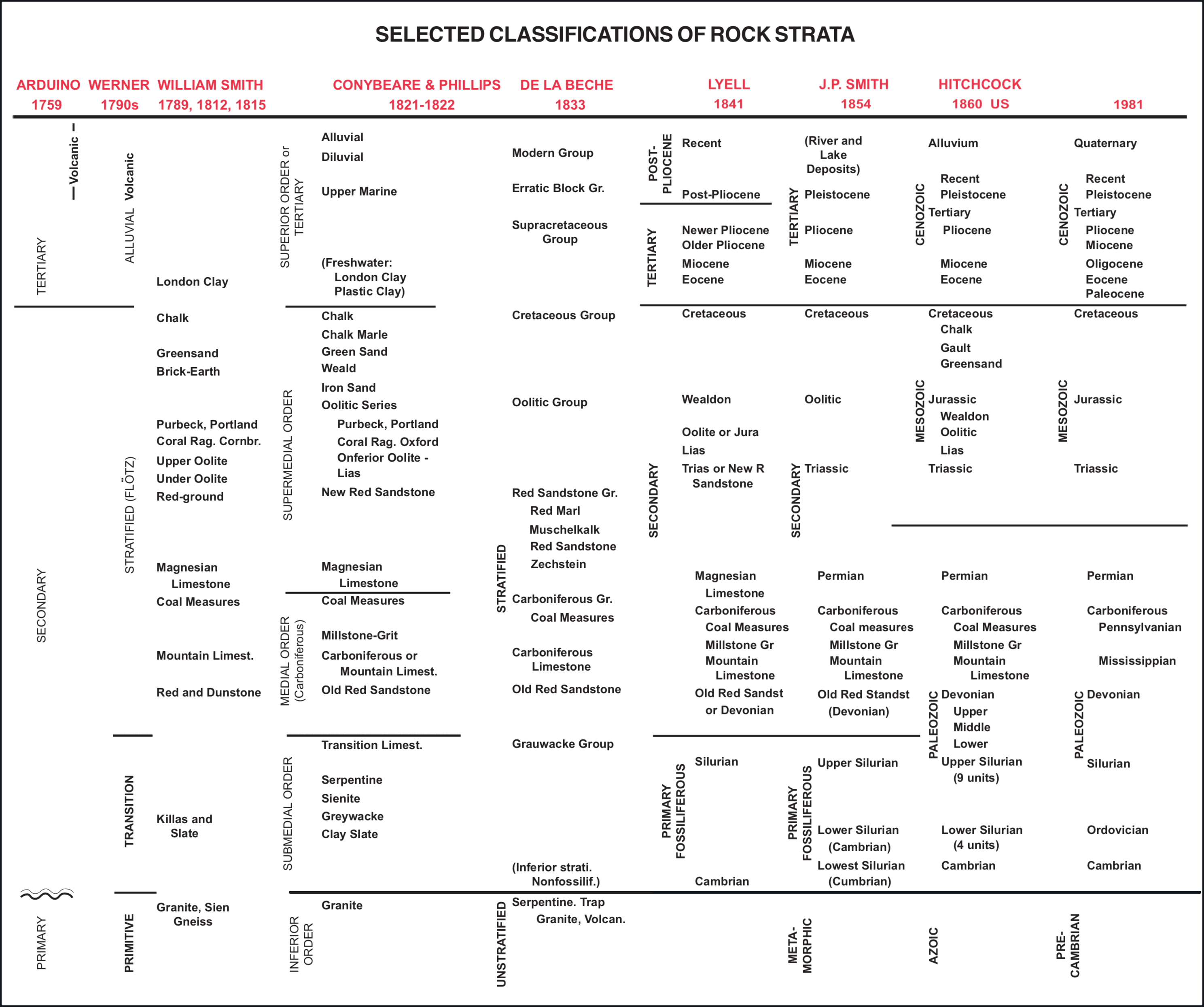
Before 1800 Concerning Fossils
There are isolated examples before 1800 of philosophers and scientists whose writings give penetrating insights on the origin and nature of fossils and fossil-bearing strata. Leonardo da Vinci (1452-1519), the Italian artist and sculptor, exhibited an understanding of processes involved in fossilization, lithification and subsequent exposure of fossils. Two centuries later Robert Hooke (1635-1703) recognized the value of fossils for reconstruction of the life and climate of former times, and Niels Stensen (Steno) perceived in the strata evidence of a chronological sequence of events in earth history (for the past "6000 years," mainly during and since the flood) including principles of superposition, original horizontality, and concepts of the role of sedimentation and erosion in burial and exposure of fossils.
But such references are generally secondary to a primary interest, and are widely separated in space and time. Far more pervasive were myths and fanciful speculations, not infrequently from men of stature from whom such statements seem strangely out of character. Teeth and bones of large animals such as mammoths (fossil elephants) were often attributed to antediluvian man, and were sometimes placed in the foyer of churches as a witness to the giant race which perished at the time of the flood. St. Augustine, in the fifth century, used as evidence of giants before the flood a large fossil tooth from which at least a hundred teeth of an ordinary size might be made (Howorth 1887:18). In 1726 J. J. Scheuchzer identified the skeleton of a giant salamander as from "one of those infamous men whose sins brought upon the world the dire misfortune of the deluge," naming it appropriately, Homo diluvii testis, which means "witness of deluge man" (Zittel 1901:20). Ezra Stiles, President of Yale, in response to an inquiry from Thomas Jefferson (1784), suggests that the "mammoths of Siberia all truly belong to an animal race in the shape of men, called Giants in the Scriptures" (Dunbar and Waage 1969:60-61).
Insofar as the nature of fossils and strata were understood, however, they presented little if any problem at that time for biblical views, generally being used rather as confirmatory evidence that the flood once covered the earth. Tertullian (c.160 - c.230 A.D.) and other early church fathers cited as evidence of a universal flood the existence of marine shells on hilltops (Rudwick 1976:36-37). The well-known skeptic Voltaire (1694-1778), perceiving fossil evidence as a threat, contrived a variety of arguments in an attempt to discount the weight of evidence. Fearing that news of the discovery of marine fossils in various upland regions of Europe might be used in support of the Genesis flood, he "fought desperately the growing results of the geologic investigations" by proposing alternative, albeit far-out, explanations, e.g., that fossils were from the spoiled remains of fishes intended for food and discarded by Crusaders returning from the Holy Land (White 1896:229).
Fossil-bearing strata were generally attributed to a single event the Genesis flood. Hence successive periods of time, origin of new species, and successive creations were not necessary. A literal six-day creation week a few thousand years ago was the prevailing view, although such a position had been questioned from time to time.
THE FORMATIVE PERIOD OF GEOLOGY 1785-1850
The conjunction of insights that resulted about the turn of the century from a systematic and comparative study of fossils and the recognition of the value of fossils for correlation of strata opened broad new vistas, thereby stimulating extensive studies. Students began to look again at the rocks of their own districts, as well as those of remote areas of the world, rugged mountain areas of Europe, Asia and even America. Geology earned a place in the academic disciplines, with famous men occupying the chairs: William Buckland at Oxford and Adam Sedgwick at Cambridge. This was a period of rapid change, of controversy over models of rock formation and earth history. The geologic column was introduced during these decades, and became an integrating concept. The welter of new views initiated sharp conflicts between interpreters of Genesis and of geology, many of which still plague conservative Christians today.
We shall comment briefly on several of the major innovators in the early part of this period. Our purpose is to gain an acquaintance with the persons who founded geology; to highlight relevant conceptual and methodological advances; and to understand prevailing theories, important because theories both derive from and, in turn, influence observation and interpretation.
Abraham Gottlob Werner (1749-1817)
Within a few years of Werner's appointment in 1875 as professor at a small, obscure School of Mines in Freiburg, Saxony, the school was "raised to the rank of a great university," with "men already distinguished in science" coming from all parts of Britain and Europe to study under the "great oracle of geology" (Lyell 1834:82). A penetrating mind with a rich store of knowledge, together with a charm and eloquence, attracted and kindled enthusiasm among his students, contributing to his enormous influence. Also to his credit were his use of exact methods of field observation and description, the introduction of a precise terminology for describing strata, and most of all the development of a superior classification of rocks based on mineral composition all essential if geology was to be elevated to a science in its own right.
Because "he indulged in the most bold and sweeping generalizations," and tended toward dogmatism on fundamental theories, several of which were proven false even during his lifetime (Lyell 1834:82), he became one of the most controversial figures in the history of geology, though it was not the great master but his students and disciples who engaged in the dispute.
Early in his career Werner developed a unique theory of the origin of strata which was to become the basis for his chronological scheme of classification. His five basic series or suites of strata were an expansion and modification of the earlier systems of Lehmann, Füchsel and others, and in certain respects an enormous step backward from them. Nearly all of the rocks igneous [1], metamorphic and most sedimentary he believed to be chemical or mechanical precipitates deposited during successive epochs from a primeval turbid ocean which enveloped the entire earth. These universal envelopes, like the skins on an onion (onion-coat theory), whether folded, tilted or flat-lying, were held with few exceptions to have been deposited in the same position they now occupy. Because of the important role of the sea, his followers were often called "Neptunists" after Neptune, the god of the sea.
The discovery, about the same time, by James Hutton and his disciples of the true nature of igneous and metamorphic rocks, together with more accurate insights into the nature of sedimentary rocks, led to decades of stormy controversy (see cover photograph). Because of Hutton's stress on the role of heat in the formation of rocks which cooled from a molten beginning, and his belief that heat also contributed to the consolidation of sediments, his followers were called "Vulcanists" or "Plutonists" after the god of the underworld, Pluto. Europe was divided into two camps: Werner's loyal students and the followers of Hutton. The overwhelming dominance of Werner's views, his position of unrivaled authority among his followers, especially on the continent where he became for geology "a kind of scientific pope," retarded the development of stratigraphy (Krumbein and Sloss 1958:11; Lyell 1834:81-82; Ospovat 1969:242-256).
James Hutton (1726-1797)
An early synthesis of Hutton's views given as a paper to the Royal Society of Edinburgh in 1785, while immediately controversial, was ultimately expanded into a two-volume work, The Theory of the Earth, published in 1795.
Hutton's major points, carefully reasoned and bolstered by field observations, were a refutation of the central thrust of the Neptunism of Werner. He advocated the origin of basalt from volcanoes and granite from magma. He associated the chemical and mechanical processes of weathering of rocks with the formation of sedimentary particles, thus showing clearly for the first time the essential relations between denudation of rock surfaces by wind, water, and gravity to transport and deposition of sediments in sites of accumulation where they were consolidated into sedimentary rocks (Zittel 1901:71). In contrast to Werner's view that younger rocks could be precipitated within as well as above older rocks, Hutton enunciated the principle of superposition (Krumbein and Sloss 1958:12).
Phenomena which might appear at first sight to bespeak catastrophe could result from ongoing processes if time were interjected into the picture (Figures 1-3). Taking "the present as the key to the past," the famous dictum of uniformitarianism, he refused to speculate on origins, maintaining that "we find no vestige of a beginning, no prospect of an end." According to John Playfair, his close friend and frequent companion on geological excursions, he did not deny a beginning but only maintained that evidence of a beginning is not accessible through science.
Like Werner, Hutton did not participate in the debate, and he died in 1797 before it reached its zenith. Controversy raged not only with Wernerians but with the early catastrophists over the reality and results of cataclysmic events (later catastrophists allowed that uniformity might prevail between cataclysms). With Neptunists the origins of basalt, of granite, of sedimentary rocks, etc., were sore points. Hutton was attacked by many Christians as an infidel and charged with "warping everything to support the eternity of the world," of deposing the "Almighty Creator of the universe from His office" (see Lyell 1834:97).
Most of the principles that Hutton introduced were eventually incorporated into geology, profoundly influencing the course of inquiry down to the present time. Elements of his theory, such as the role of heat in consolidation of sediments and, more importantly, the idea that rates and magnitudes of geologic activity are approximately constant, have been or are now being rejected or revised.
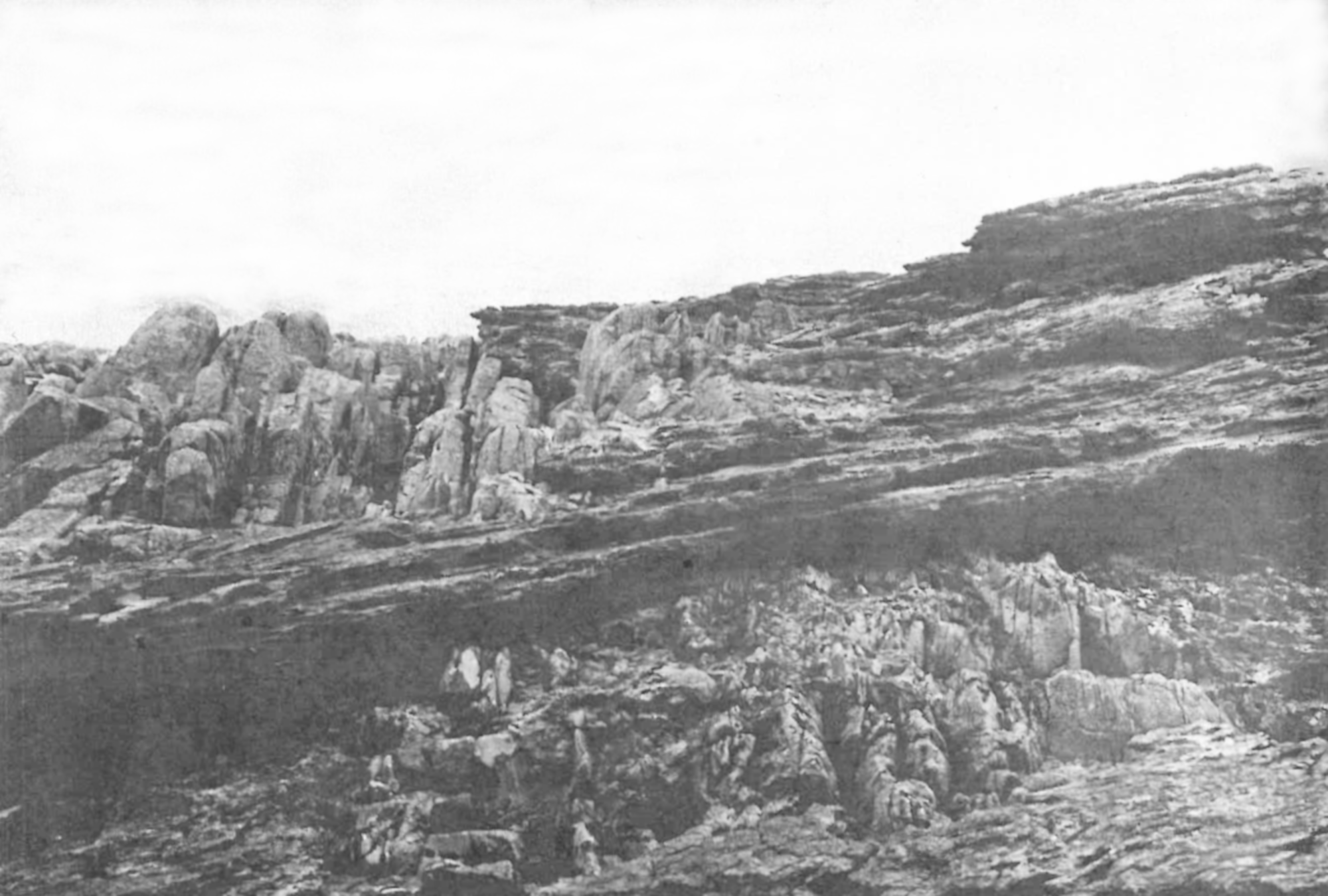
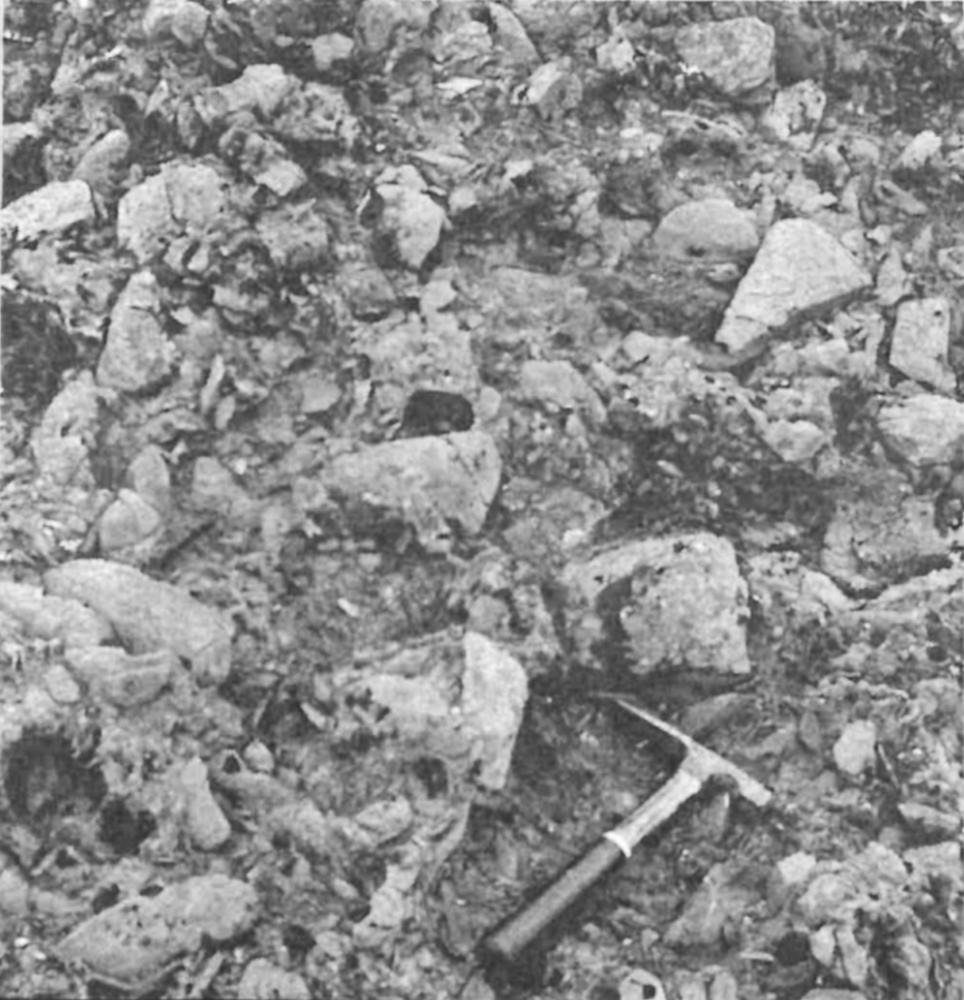
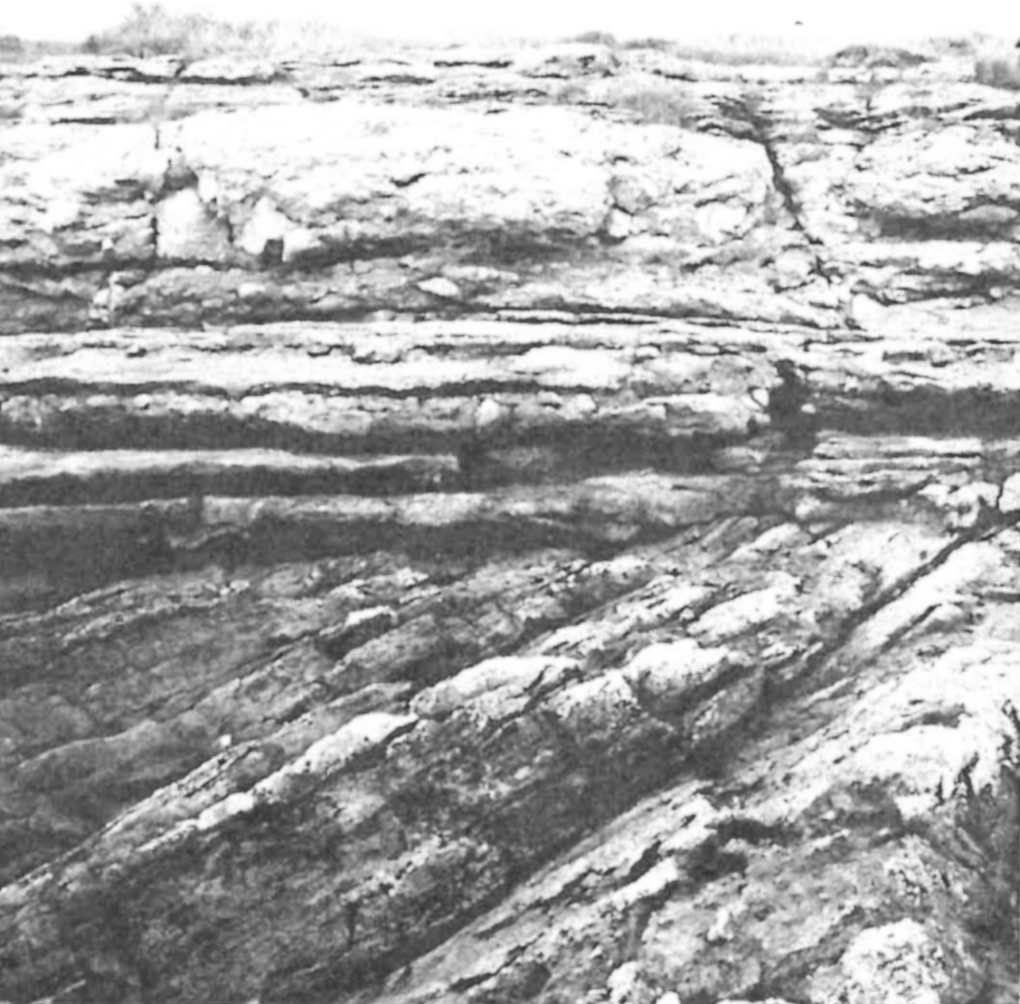
William Smith (1769-1839)
William Smith has been referred to as an "ignorant English land surveyor," (Price 1926:51) and otherwise as a "self-taught genius of rare originality and with exceptionally keen powers of observation" who was able to "elucidate the structure of his native land with such clearness and accuracy that no important alteration has had to be made in his works" (Zittel 1901:111-112).
His first major contribution was the recognition in 1798, while constructing canals through fossiliferous rock strata in Southern England, that fossil assemblages often include forms that are restricted to and typical of zones, formations or larger segments of the column (Figures 4 and 5).
He determined that the occurrence of such fossils is consistent so that they may be used together with lithology and other features as "guides" in mapping and correlating strata (reported the following year in 1799). Secondly, he applied the method and within a few years (1815) had produced the first geologic map of an area of regional extent England, Wales and a part of Scotland. Independently of Smith, Cuvier and Brongniart discovered the value of "guide fossils" while working through the series of strata in the Paris Basin in France.
As strata have been studied in all parts of the world, the order has been found to be consistently reliable in numerous sections, although extensions of the range of some "guide" or "index fossils" are made from time to time. This discovery by Smith the value of fossil assemblages, guide fossils, in complementing other means of comparison, and making possible correlation over greater distances was undeniably the most important geological breakthrough of the century, essential for establishing a geologic column of more than regional application. As with any methodology there are various theoretical problems and limitations, but generally not seriously affecting the usefulness of the method.
Appropriately in the annals of geology William Smith is often referred to as the "Father of English Geology," or simply as "Strata Smith."
FIGURES 4 and 5. Jurassic beds near Lyme Regis on the south coast of Dorset, England, with ammonites from one of the resistant carbonate beds. While studying these beds and others about 1800, William Smith developed the concept of "guide fossils." A few years later these strata were to yield the specimens from which Evard Home, W. D. Conybeare and others reconstructed and described (1814-1824) Ichthyosaurs and Plesioseurs, two hitherto unknown great groups of extinct marine reptiles.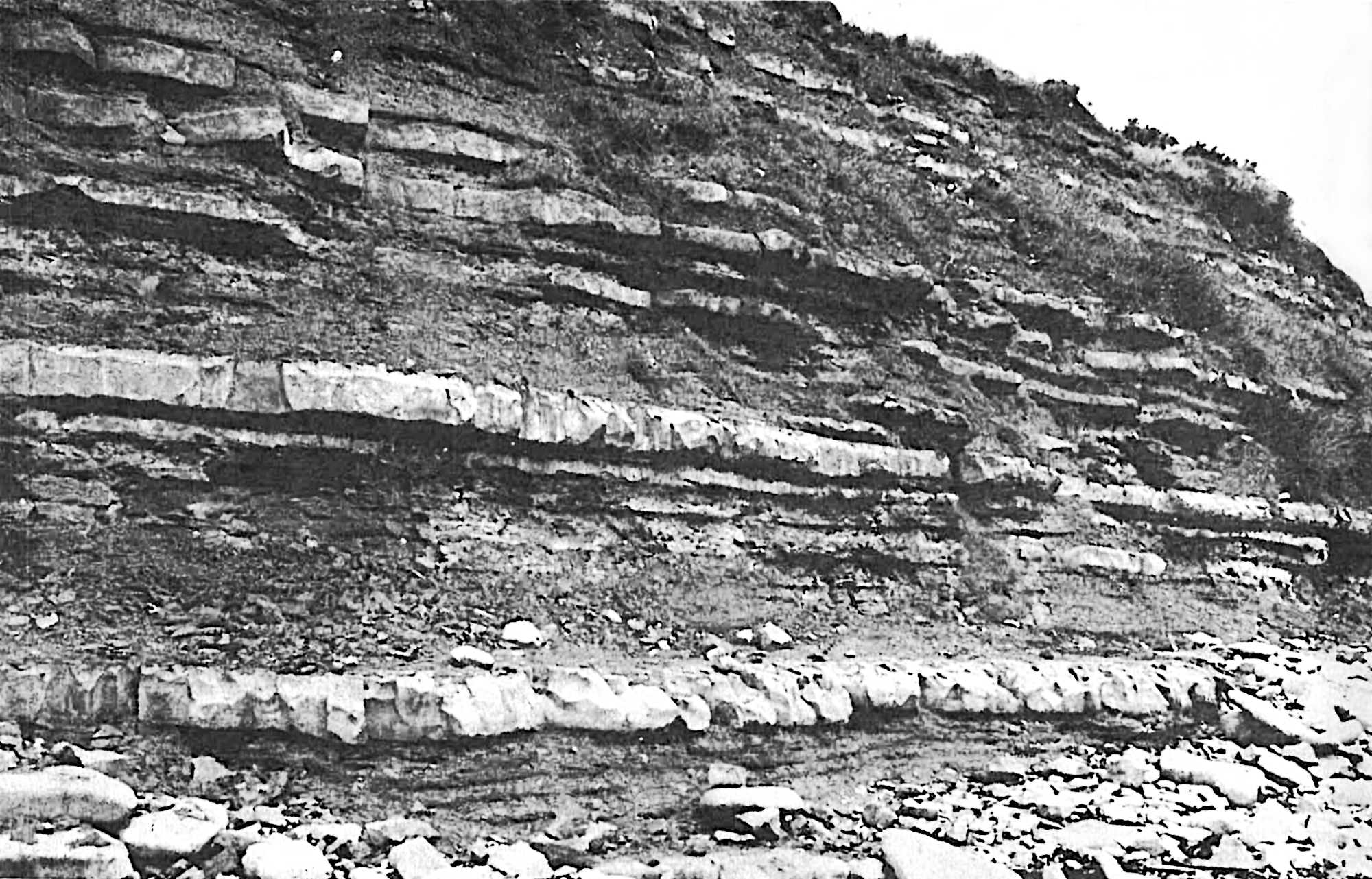
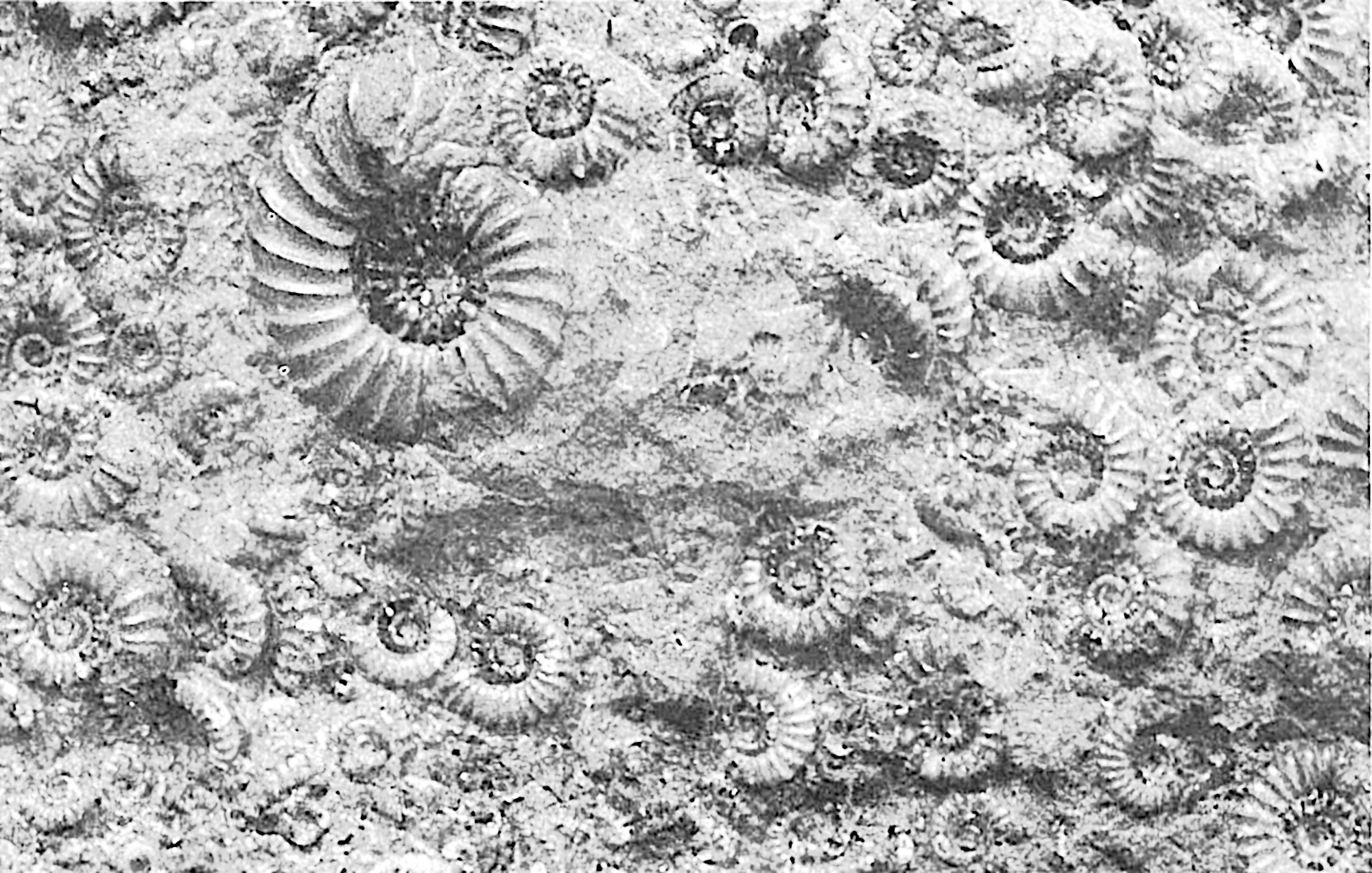
Georges Cuvier (1769-1832)
Although the structure of vertebrates is far more complex than that of sea shells, plants and other lowly forms, when known and understood in detail, even limited parts such as the individual teeth or bones most likely to be preserved as fossils can be used to determine whether a reptile, amphibian, mammal or other vertebrate is represented. And if it happens to be the right tooth or bone, accurate diagnosis of the family, genus or species is often possible.
Cuvier had the interest, the keen intellect, the drive, the originality, and the ample resources (the French government) to make, for the first time, vast comparative studies of a wide range of living as well as fossil vertebrates so that they might be accurately identified and properly related on fundamental characteristics. Thus, in the early years of the 19th century the study of fossil vertebrates advanced from almost total darkness to broad daylight. Since the basis of vertebrate paleontology is essentially the comparative anatomy of fossil forms, Cuvier is justly recognized as the founder of both comparative vertebrate anatomy and vertebrate paleontology. His Researches on Fossil Bones is a classic. "In the whole literature of comparative anatomy and paleontology there is scarcely any work that can rank with this great masterpiece of Cuvier" (Zittel 1901:137).
Once Cuvier had blazed the trail, others followed. William Buckland of Oxford and Gideon Mantell, the physician-paleontologist, applied the method with great success to vertebrate remains in Britain. A few years later, Sir Richard Owen produced a magnificent series of studies on fossil reptiles, and a monumental work on Odontography (1839-1845). Many other workers entered the field both in the old and new world. Whole new vistas of ancient land life were now, for the first time, opened to view. A key had been forged, a breakthrough necessary for meaningful study and correlation of formations in which land vertebrates are the major fossils preserved (terrestrial biostratigraphy).
But Cuvier did not confine his studies to these topics. With his friend and associate, Alexandre Brongniart (1770-1847), almost every week for four years he made excursions to the country in the environs of Paris making detailed studies of the stratigraphy, structure and paleontology of the Cretaceous and Tertiary series of formations. Their work on the Paris Basin, published in 1808 and expanded in 1811, remains a classic for accurate observation and original application of principles of paleontological and stratigraphical analysis.
These early studies on the Paris Basin during the first decade of the century led Cuvier to the theory of catastrophes, a theory that, with modifications and acceptance by many of the most respected geologists of that time, profoundly affected geological research and interpretation for the half century during which the geologic column was founded. Only a few of the lines of evidence which led him to this conclusion will be considered.
Cuvier speaks of questions and ideas that haunted him, even tormented him all during his researches (Cuvier 1817:174). He was much impressed by the striking changes which often marked the boundaries between successive formations: the abrupt change in lithology; sometimes an erosional break; the marked changes in the fossil communities from marine, to fresh water, to marine, to land, etc. The shells were, Cuvier (1817:8-9) observed, "almost everywhere in such a perfect state of preservation, that even the smallest of them retain their most delicate parts, their sharpest ridges, and their finest and tenderest processes." They must therefore, he reasoned, represent successive communities buried where they lived rather than being transported from distant areas and buried level upon level.
He and Brongniart early recognized the phenomena of restriction of distinctive fossils to particular zones, formations or series guide fossils and applied this tool in their stratigraphical studies. Moreover, they observed a pattern or trend in the change from level to level. Of the shells found in the upper, more recent levels, he states that the "eye of the most expert naturalist cannot distinguish from those which at present inhabit the ocean." Forms of life recovered from successively more ancient strata were observed to become progressively more strange and "peculiar" (Cuvier 1817:13, 108-109).
Among the numerous other features that seemed to call for a long interval of time between formations was the presence of a "breccia of chalk fragments" at the base of the overlying clay beds which was taken to indicate that the "chalk was already solid when the clay was deposited"; that is, lithified chalk cobbles were recycled into the next younger deposit (Geikie 1905:368-369).
The picture that emerged then was one in which long intervals of occupation and stability were thought to be separated by tectonic revolutions, destruction of life, and eventual repopulation, possibly by migration of life from an unaffected region in the world (Cuvier 1817:125-126) [2].
A man of religious faith, he resolved the stratigraphic evidence with the biblical account by explaining that "a great and sudden revolution, the epoch of which cannot be dated much farther back than five or six thousand years ago," which had "buried all the countries which were before inhabited by men and by the other animals that are now best known," was the last great revolution now "thoroughly established in geology" (Cuvier 1817:171). This seemed to him to fit the data because man and his artifacts were only known to be associated with the most recent deposits.
An eloquent statement concluding his essay on the Theory of the Earth clearly reflects his attempt at reconciliation of Scripture and geology. "And mankind, to whom has been allotted only an instant on the earth, would have the glory of recreating the history of the thousands of centuries which preceded his existence, and the thousands of beings which have not been his contemporaries" (Quoted by Gillispie 1960:290-291; cf. Cuvier 1817:171, 178-181).
Cuvier was honored by his own people and government, and he became very famous abroad. Such fame certainly contributed to the wide acceptance of his theory. Although very different in substance from the theories of Werner and Hutton, Cuvier's theory of catastrophes again called for long ages in explaining the geologic history of the world. It was strenuously opposed by many conservative theologians and laymen, while others embraced the idea.
RESUME
The work of Werner, Hutton, Smith, Cuvier and several contemporaries, although sometimes fraught with controversy and beset by imperfect theories, had succeeded in laying the groundwork that made a scientific study of geology possible. The next three decades were a time of enormously rapid progress. Workers focused on the crust of the earth in their own countries and traveled to distant parts of the world to compare the strata and fossils; the geologic column was formulated much as it exists today in its broader features; heightened tensions resulted from attempts to harmonize earth history with the biblical record. These decades are considered in Part II in the next issue of ORIGINS.
FOOTNOTES
[1]In his classification of strata, only those lavas demonstrably associated with volcanic vents were included in the Volcanic Series, which Werner, like several before him, considered to result from subterranean fires of combustible materials such as coal. One of the stormiest controversies of the early 19th century concerned the origin and classification of extensive enigmatic basalt deposits in the British Isles, France and other parts of Europe that were not clearly associated with discernable volcanic vents (see cover photo). (For an extended discussion, see Geikie 1905).
[2]Other workers, especially in England, introduced the idea of new divine creations of progressively higher forms of life after each catastrophe, whereas Cuvier, while explicitly denying that "new creations" were "required," from time to time made statements which clearly indicated that he considered origin at successive intervals a possibility. For example: "I do not pretend that a new creation was required for calling our present races of animals into existence. I only urge that they did not anciently occupy the same places, and that they must have come from some other part of the globe" (Cuvier 1817:125-126). Concerning man: "He may have then inhabited some narrow regions, whence he went forth to repeople the earth after the cessation of these terrible revolutions and overwhelmings" (p. 131). On the other hand, "we are also led to conclude that the oviparous quadrupeds began to exist along with the fishes, and at the commencement of the period which produced the secondary formations; while the land-quadrupeds did not appear upon the earth till long afterwards, ... whence there is every reason to conclude that these animals have only begun to exist, or at least to leave their remains in the strata of our earth ..." (pp. 108-109). "... And man, to whom only a short space of time is allotted upon the earth, would have the glory of restoring the history of thousands of ages which preceded the existence of the race, and of thousands of animals that never were contemporaneous with his species" (p. 181).
REFERENCES CITED
- Adams, F. D. 1938. The birth and development of geological science. Reprinted 1954 by Dover Publications, New York.
- Conybeare, W. D. and William Phillips. 1822. Outlines of the geology of England and Wales. W. Phillips, London. Reprinted 1978 by Arno Press, New York.
- Cuvier, M. 1817. Essay on the theory of the earth. Edinburgh. Reprinted 1978 by Arno Press, New York; translated from 1812 book.
- de la Beche, Henry. 1833. Manual of geology. 3rd ed. London.
- Dunbar, Carl O. and John Rodgers. 1957. Principles of stratigraphy. John Wiley & Sons, New York.
- Dunbar, Carl O. and Karl M. Waage. 1969. Historical geology. 3rd ed. John Wiley & Sons, New York.
- Geikie, Archibald. 1905. The founders of geology. Dover reprint, New York.
- Gillispie, C. C. 1960. The edge of objectivity. Princeton University Press, Princeton, New Jersey.
- Hitchcock, Edward. 1860. Elementary geology. New York.
- Howorth, H. H. 1887. The mammoth and the flood. Sampson Low, London.
- Krumbein, W. C. and L. L. Sloss. 1958. Stratigraphy and sedimentation. W. H. Freeman, San Francisco.
- Lyell, Charles. 1834. Principles of geology. Vols. I-IV, 3rd ed. John Murray, London.
- Lyell, Charles. 1841. Elements of geology. Vols. 1 and 2, 2nd ed. John Murray, London.
- Ospovat, Alexander M. 1969. Reflections in A. G. Werner's "Kurze Klassifikation," in Cecil J. Schneer, ed. Toward a History of Geology. MIT Press, Cambridge, Massachusetts.
- Price, George McCready. 1926. Evolutionary geology and the new catastrophism. Pacific Press Publishing Association, Mountain View, California.
- Putnam, William C. 1964. Geology. Oxford Press, New York.
- Rudwick, Martin J. S. 1976. The meaning of fossils. 2nd ed. Neale Watson Academic Publications, New York.
- Smith, John Pye. 1854. The relation between the Holy Scriptures and some parts of geological science. Henry G. Bohn, London.
- White, A. D. 1896. A history of the warfare of science with theology. Vol. 1. Reprinted 1960 by Dover Publications, New York.
- Zittel, Karl von. 1901. History of geology and palaeontology. Walter Scott, London.
